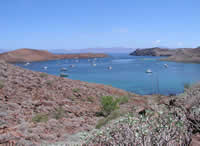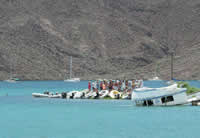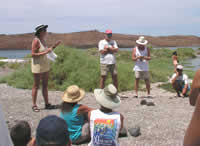| Volume
99
Northern Sea of Cortez-A Month's "Vacation?"/Hurricane Fire Drill,
August 20-28
Normal
people (a euphemism for non-cruisers) would consider a month's
sailing a windfall in the vacation category. Yet the two captains,
sitting in the air-conditioned salon on Tackless II in the marina
in San Carlos, seriously wondered if a mere month would be worth
all the effort to turn the condo back into a sailing machine
and travel 200 miles or so north and back again. So is revealed
the evolution of a cruiser's sense of time&especially one
under the influence of air-conditioning.
We are accustomed
to our schedule being dictated by no more than respect for seasonal
weather fluctuations. The moment we have a
set date for anything -- a visitor, a holiday, a wedding, for example
-- the pressure is abruptly on. On this occasion, the controlling
event was an appointment for knee-replacement surgery for Don's
Dad. The moment we learned it was a possibility, we agreed that
the two wanderers with the flexible schedule should fly "home" to
Indiana to provide whatever help and comfort we could. Outsmarting
ourselves, we got the idea it would happen in August, dovetailing
conveniently with our trip to San Carlos for the watermaker installation.
These things, however, obviously don't unfold according to OUR
schedule! So, there we were with approximately a 4-5 week window,
trying to decide if it was WORTH the trouble to dash up to our
favorite part of the Sea. Really, we'd like to believe it was the
air-conditioning that confused our minds.
Fortunately, the alternatives didn't add up. Traveling around
the States to visit everybody would be fun but too expensive. Traveling
inland around Mexico in September would be too hot. Just staying
in the air-conditioning -- we were still clear-headed enough to
see -- would be too boring. And, so, the morning of August 20th,
we backed out of the slip, fueled up and struck out.
We were pleasantly surprised to find we had near perfect conditions.
We had thought that yet again, the wind would be too light and
we would have to motor. But exactly the opposite of our crossing
TO San Carlos, despite the light wind, T2 picked up her skirts
and sailed. We virtually sailed the whole way! We even managed
to fly the cruising spinnaker (which is now permanently dubbed
the BFS) for several hours. And the night sailing was lovely: gentle,
uneventful (no chubascos), with the rising Mars like a spotlight
on our stern. (In late August Mars was making its closest passage
by Earth in thousands of years!)
We stopped for an overnight in Bahia San Francisquito, then without
pause took advantage of the settled conditions and scooted out
to one of our favorite spots, Isla Salsipuedes. We were thrilled
to have it to ourselves and were ready to settle in for several
days, but it was not to be. At 4am the wind piped up abruptly to
20 knots coming straight into the narrow rock slot in which we
were anchored. Since it takes a while for the seas to build and
since we always anchor for storm conditions, there was no immediate
need to bolt. We took time for coffee and breakfast and to listen
to the net.
At which time
we learned of Hurricane Ignacio's birth. Interestingly, although
we have
felt this summer to have much more heat and "weather" than
last summer, tropical cyclone-wise it has been much milder. Last
year there was a steady stream of storms forming south of Acapulco
and marching westward in the early months of summer. Not the case
this year. So it was a bit of a surprise for everybody when Ignacio
suddenly congealed from an area of low pressure just southeast
of Cabo San Lucas. The first forecasts had it tracking up the Pacific
Coast of Baja. Baja is nowhere that wide despite its mountain barrier,
so although the storm was still five hundred or so miles south
of us, we agreed immediately to follow the Two Captains' first
rule of hurricane preparation: Get thee to the best hurricane hole
you can and stake out a spot.
 And so we sailed
to Puerto Don Juan. Puerto Don Juan, notched into the southern
lip of Bahia Los Angeles, is the best hurricane
hole in the northern Sea, and one of only five acceptable holes
in the entire stretch of Baja. We were the thirteenth boat in the
anchorage. By the next morning that number had doubled, and in
the end there were over thirty boats seeking refuge in this single
bay. Puerto Don Juan is a nearly perfect hurricane hole, with its
sole flaw being that it is fairly deep. The average depth throughout
the center is 30-40 depending on the tide, and the storm was due
to pass over us on the day of the new moon, when tides would be
a full ten feet! Obviously, with that many boats, each with its
individual ground tackle capacity and theories, we were going to
need a lot of coordinated effort to make the jigsaw puzzle of free-swinging
boats fit. Equally obviously, there was a wide range of experience
among the cruisers. Some had storm experience in the Pacific Northwest,
a few boats had experienced Hurricane Juliet two years ago here
in the Sea, and all had had Chubasco experience in the preceding
months. However, a half-hour of forty or fifty knot gusts is a
far cry from twelve hours of 60+. Very few of the cruisers around
us had really thought through all the preparations necessary to
withstand a full-blown hurricane. And so we sailed
to Puerto Don Juan. Puerto Don Juan, notched into the southern
lip of Bahia Los Angeles, is the best hurricane
hole in the northern Sea, and one of only five acceptable holes
in the entire stretch of Baja. We were the thirteenth boat in the
anchorage. By the next morning that number had doubled, and in
the end there were over thirty boats seeking refuge in this single
bay. Puerto Don Juan is a nearly perfect hurricane hole, with its
sole flaw being that it is fairly deep. The average depth throughout
the center is 30-40 depending on the tide, and the storm was due
to pass over us on the day of the new moon, when tides would be
a full ten feet! Obviously, with that many boats, each with its
individual ground tackle capacity and theories, we were going to
need a lot of coordinated effort to make the jigsaw puzzle of free-swinging
boats fit. Equally obviously, there was a wide range of experience
among the cruisers. Some had storm experience in the Pacific Northwest,
a few boats had experienced Hurricane Juliet two years ago here
in the Sea, and all had had Chubasco experience in the preceding
months. However, a half-hour of forty or fifty knot gusts is a
far cry from twelve hours of 60+. Very few of the cruisers around
us had really thought through all the preparations necessary to
withstand a full-blown hurricane.
By the next day the storm had grown into Hurricane Ignacio, and
its projected track had been shifted from up the outside of Baja
to one that would carry it northwest right along Baja's eastern
coast. In other words, right over the top of pretty near every
cruiser summering in the Sea of Cortez! Suddenly it was a real
and imminent (although incredibly slow moving) issue. About now,
as you can imagine, the Two Captains were seriously reconsidering
our decision to abandon condo status in San Carlos!
One of the cruisers proposed we have a meeting on the beach of
all the boat crews and asked if Don and I would speak about our
experiences preparing for hurricanes in the Caribbean. Don and
I put together a checklist of the considerations that we would
follow before and during a hurricane, and that formed the outline
for a really good discussion, leading (amazingly) to a fairly general
consensus of how to proceed.
 
The biggest issue was how to anchor. Back home in the Virgin Islands,
our preferred strategy was to stake ourselves out in the mangroves
with, for example three to four anchors off the bow (or one side
of the boat) and as many line as possible from the stern (or other
side) tied into the trees. Unfortunately that strategy was not
available to us in Don Juan where there is almost nothing green,
let alone mangroves! With as many boats around us as we had, Don
and I would have chosen to set at least two anchors to limit the
swing radius and reduce the effects of a wind reversal. The west
coast sailors -- who are more used to winds switching around in
all directions unlike the Caribbean where wind comes mostly from
the East feel more strongly about the negatives of this approach
(the anchor ropes winding up) than the advantages. Since you can't
have some boats on two anchors and others on one with the kind
of scopes needed and given the depth of Don Juan and the limited
resources of some of the boats, the consensus was to all swing
on one good anchor and have any others available ready to deploy
should the first drag.
Fortunately, we never got to test the strategy. By the morning
of August 26, Ignacio had surprised observers by wiggling its way
more westerly over land, a position that would rapidly deflate
its force. Plus, its new track would deal only glancing blows (relatively
speaking) on the cruising communities in La Paz and Puerto Escondido
before bearing off westward into the cool Pacific. On T2 the sigh
of relief was probably even greater than that of our less experienced
colleagues. Despite our role as advocates of early and thorough
hurricane prep, aboard T2 we'd hardly made more than a start. That
was because Don found himself busy full time between Spectra water
maker service calls (nothing like a captive audience) and on-site
anchoring counsel for all the boats nearest us!The good news was
that we didn't have a big job getting the boat put back together
before making our escape.
|